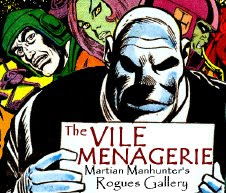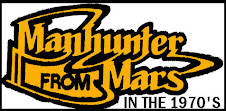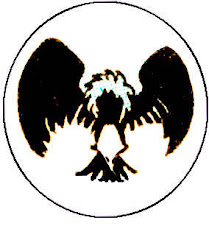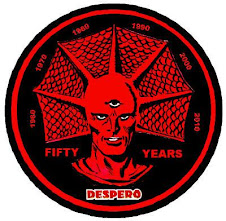
This another great intro from Tom, who even schooled me (I never knew about how Michael Netzer was formally introduced to J'onn J'onzz.) Check out the convincing counterfeit page by downloading it in PDF format...
Sailors fighting in the dance hall
Oh man! Look at those cavemen go
It’s the freakiest show
Take a look at the Lawman
Beating up the wrong guy
Oh man! Wonder if he’ll ever know
He’s in the best selling show
Is there life on Mars?
—— David Jones (alias David Bowie)
In the summer of ‘65, around the same time that another Jones, almost as strange as the one who wrote those lyrics, was saving the world from Iwangis, the Creature King, or maybe the mirror Martian Manhunter, or the giant genie of Gensu, a camera attached to the unmanned Mariner 4 spacecraft took some photographs of the surface of the red planet, delivering the sad news to us Earthlings that no, there was no life on Mars. No green men, either even littler than David or as big and burly as our pal J’Onn, walked on that arid, crater-pocked surface. No water flowed through those famous Martian canals Giovanni Schiaparelli had seen in his telescope back in 1877. Later astronomers with better telescopes had already proven, decades before Mariner, that the canals were an optical illusion. (Mariner didn’t take any pictures of the Cydonian region. It would be another eleven years before Viking I captured images of what appeared to be a giant carving of a human face, and another three decades after Viking that higher resolution photos taken by the Mars Reconnaissance Orbiter would reveal that the face on Mars was as illusory as the canals.) Maybe the Martians were shy, and didn’t want their civilization to be photographed. We all know that invisibility is one of J’Onn J’Onzz’s Martian powers. Maybe they lived underground, because maybe that’s where the water really was. (Speculation continues to this day about the existence of Martian underground water deposits.) But in the 1960s everyone knew that soon any questions about life on Mars still left unanswered by Mariner’s dreary photolog would be settled once and for all. John F. Kennedy had vowed that before the decade was over, men would set foot on the Moon. Surely this would be followed in another few years, before the end of the ‘70s, by a manned mission to Mars, and if there were any Martians to be found, our astronauts would find them.
In the summer of ’68 there were plenty of other things to think about besides space exploration. Thus far there had been six Apollo missions. Apollo 6, an unmanned test flight of the Saturn V launch vehicle, was launched on April 4th, the same day Martin Luther King was assassinated. Two months later Democratic presidential candidate Robert F. Kennedy was shot. And two months after that was the 1968 Democratic National Convention. The division between those who wanted an immediate end to the war in Viet Nam and those who still thought victory was possible didn’t kill the Democratic Party, but it wrecked their convention. An overreaction from the police didn’t help either. For four days in August the news footage from Chicago was almost as violent as the daily televised images from Viet Nam, leaving many to wonder if a dispute over a civil war in Asia might lead to second American civil war. Besides the folks at NASA, who else could spare a thought for life on other worlds?
Comic book writers, that’s who. Given the six month lead-time for comic book production, the script for this volume’s first reprinted story from JUSTICE LEAGUE OF AMERICA #71, with its May, 1969 cover date, but its actual on-sale date of February, 1969, would likely have been written in August, 1968. So while most Americans were wondering what to do about Viet Nam and race relations, Denny O’Neil had to figure out what to do with the Martian Manhunter.
J’Onn J’Onzz had been one of the founding members of the JLA, appearing in the team’s debut stories in THE BRAVE AND THE BOLD #28-30 and in every issue of the League’s own book up to #24. But he’s in only 10 of the next 24 issues, and in 6 of the next 13 after that (not counting his appearances in three giant-size reprint issues). Finally, more than a year would separate his appearance in issue #61 (March, 1968) from his next appearance in #71 (May, 1969). Whatever popularity J’Onn had enjoyed had been declining for years, since the early ‘60s during his last years as a DETECTIVE COMICS back-up feature, when the book’s sales were declining, not necessarily through any fault of J’Onn’s, but mainly because readers were tiring of editor Jack Schiff’s silly treatment of the lead feature, Batman. J’Onn was booted from DETECTIVE COMICS when a new editor, Julius Schwartz, took over. His new home, HOUSE OF MYSTERY, was an even worse seller than the Schiff era DETECTIVE COMICS. His appearance in JUSTICE LEAGUE OF AMERICA #61 occured the same month as his last story in HOUSE OF MYSTERY, in issue #173 (March-April, 1968). He wasn’t given a new home after HOUSE OF MYSTERY, and for years afterward had to settle for guest appearances with his fellow Justice Leaguers. This volume of THE MARTIAN MANHUNTER ARCHIVES covers that decade-and-a-half long period from 1968-1984, when not just J’Onn, but all of his fellow Martians, were looking for a new home.
Those familiar with the conventions of super-hero comics know that when a member of a super-hero team returns after a long absence, it is only so that he can say goodbye. So for experienced comic book readers, I’m not spoiling anything when I say that in issue #71 the Martian Manhunter resigns from the Justice League of America. He has a good reason, of course. The consequences of a civil war has rendered Mars uninhabitable; J’Onn and his fellow Martians must find a new homeworld. This takes care of the problem facing anyone who could spare a thought for DC’s fictional Martians during those turbulent times. The Apollo program was racing toward its goal of putting a man on the Moon, and would succeed in the summer of 1969, barely meeting JFK’s deadline. When astronauts would surely visit Mars a few years later, they were not likely to find any Martians. Maybe there never were any Martians, or maybe they had to leave because their entire world was engulfed by blue flame. The Martians would eventually find a new world, many light years away and likely beyond the reach of Earth’s astronauts for many centuries to come.
The remaining stories in this volume deal with the problems J’Onn and his fellow Martians face on their new home, Mars II. One in particular is of special interest, not for the story itself, which is easily the silliest in this collection (sorry, Denny), but for the influence its artist would have on future depictions of the Martian Manhunter. Readers of the previous five volumes have seen how J’Onn’s look changed during his early years, from the heavy-browed alien in his first appearance in DETECTIVE COMICS #225 (November, 1955), to the pug-nosed, square-headed bruiser in the late ‘50s and early ‘60s, and to the handsome bald fellow from the mid-60s through the mid-70s. It’s this green Mr. Clean whom we see in this volume’s first three stories. But in the fourth story the brow is back. For this we can thank artist Michael Netzer (named Mike Nasser back when he drew the story), who restored the Martian Manhunter to his original appearance in ADVENTURE COMICS #449 (January-February, 1977). When Netzer was given the assignment, he became curious about the character’s early history. It was artist, publisher and comics historian Greg Theakston who showed Netzer some of the early DETECTIVE COMICS stories. Netzer liked the alien look artist and co-creator Joe Certa had originally given J’Onn, so that’s how Netzer chose to draw him, and how every other artist has drawn him since.
In addition to getting back his brow, J’Onn would also return to Earth and rejoin the Justice League, as you’ll see in this volume’s final 3-part epic, from JUSTICE LEAGUE OF AMERICA #228-230 (July – September, 1984). The League has gone through several incarnations in the decades since, and J’Onn has played an important role in every one of them, and has even had some solo adventures from time to time. So even though, decades after Neil Armstrong set foot on the Moon, we’re still waiting for that manned mission to Mars, at least we can always enjoy the adventures of our favorite fictional Martian.
—— Wade Greenberg
Novelist WADE GREENBERG has never beaten up the wrong guy and always knows he’s in the freakiest, best selling show.






























12 comments:
Greenberg forgot to mention that David Jones was a Martian in THE MAN WHO FELL TO EARTH. He and John are practically brothers.
I know I sent you the Table of Contents. You said you liked the pic of Despero. I'll assume you're posting the intro and the ToC in the opposite order, just to shake things up, and that you didn't forget about it.
I started writing accompanying text for the TOC, and it got away from me. I decided I'd better read through your introduction to make sure I wasn't stepping on your toes. As it turned out, we went in very different directions, but I still wanted your piece out there a few days before my complementary material.
Wonderful intro, Tom, especially trying it in to the cultural and scientific events of the time. I honestly don't know how anyone survived the late 60's with all the Earth-shattering events that took place within such a short period of time.
It's kind of ironic that scientific discovery kills science fiction wonder, and I'm guessing that America's declining interest in space exploration directly correlates with the Manhunter from Mars's declining visibility in the JLA. I hope when (if) he comes back, J'onn can be relevant to today's audience while still inspiring that sense of Golden Age sci fi wonder.
And I'm glad that Greg Theakston was around to show Michael Netzer those old stories in Tec, otherwise things could've turned out differently. It's nice to know that even thirty years ago, there were people in the industry devoted to preserving its history.
Minor Tom, he was Anthean, not Martian!
But "David Jones" himself is definitely an alien of some sort. I never knew his last name was Jones. That's a complete giveaway to a secret alien identity.
The secret origin of how our hero got his brow back was revealed in an email Netzer sent me. His lengthy reply to my query provided far more information than I needed for my intro. Maybe with his permission I can foreward it to you and you can post it to the blog.
Maybe your accompanying text to the ToC could become an alternative Vol. 6 Foreword.
Tom, cool beans! My piece isn't an introduction so much as a running commentary on the collected issues. Had you gone deeper into the continuity/credits as you've done in the past, there might have been some redundancies on my part. Instead, I can just shoot off my mouth a bit, knowing you already did a proper intro.
Liss, I don't believe space exploration killed science fiction so much as created an increased demand for science fantasy. The discoveries themselves only hurt actual science, since it made something mysterious and compelling into another boring set of facts for a textbook. We want flying cars and pod people, not lifeless rocks. Regardless of the facts, convincing most people that calculated fictions are truth is child's play. Just look at politics.
To further my point, J'Onn's slow return to prominence began in 1977, the same year Star Wars was released. J'Onn failed to take advantage of that, but once he returned to Earth and dropped the '50s pulp sci-fi trappings for new age hoo-doo, his star began to rise. Mars-smars, all that matters to people is that he's an alien and he does cool stuff. I'd say his peak popularity was in the late '90s through early '00s, hardly a golden age for scientific exploration (and in the midst of further evidence that there ain't no actual Martians.)
Also, Greg Theakston's "Theaksonization" was once the primary method of reprinting old comics from the physical comics when film wasn't available. I believe computers do it today, but that was a major challenge until the '90s. He's a hero for comics historians.
"I don't believe space exploration killed science fiction so much as created an increased demand for science fantasy." That's a good point. Plus even some of the Golden Age writers (especially Bradbury) were light on the science part...The Martian Chronicles is really just fantasy.
"I'd say his peak popularity was in the late '90s through early '00s" I still haven't figured out why that is. When I think of 90's I don't think of science fiction or a general sense of wonder about alien life. (Well, there was that little Martian microbe they discovered but I doubt that had anything to do with it.) Aliens were always bad in the 90's sci fi movies.
I don't think we've lost the ability to believe things (like politics...great example), but I think we've lost a sense of wonder about things. I think as a society we're pretty cynical, though I think that trend is slowly reversing.
About "Theaksonization"...that's pretty cool. I'm always fascinated by when people collectively decide to start preserving things. I mean, how many Baby Boomers can tell you about how their mothers threw out their Mickey Mantle rookie card or how they put it in the spokes of their bike and ruined it? I'm wondering when exactly preserving comics shifted from being a practical matter (art reference, continuity, etc.) to preserving a piece of history.
Jones changed his name to Bowie so that people wouldn't confuse him with Davey Jones of the Monkees.
Shoot away, Frank. If your ramblings are long enough, maybe, with a little polishing, they can turned into a proper Foreword.
Netzer says you can post the email he sent me. Check your Yahoo.
"I still haven't figured out why that is. When I think of 90's I don't think of science fiction or a general sense of wonder about alien life."
There's the rub-- it wasn't about science fiction. I think sci-fi is actually a liability for J'Onn.
Two factors suddenly made the Martian Manhunter popular in the 1990s: the accumulated good will from quality characterization in various series throughout the decade, and most importantly, association. DC and Morrison made such a big deal about the JLA being their pantheon, the Magnificent Seven heroes of their entire line finally reunited on one team. SUPERMAN! BATMAN! WONDER WOMAN! (The new & quite popular) GREEN LANTERN! (The recently revitalized) FLASH! (Ditto) AQUAMAN! and... the Martian Manhunter? Fans of the Justice League prior to 1996 knew and often liked J'Onn J'Onzz, but it was really the influx of new readers curious about this fifth Beatle who was supposedly "as powerful as Superman," and who had earned the respect of the hard-to-please Dark Knight that spotlighted him. It also didn't hurt that Morrison not only used him well, but had him typically outshine the Amazing Amazon & Sea King (plus outrank everyone but the World's Finest duo.)
"I'm wondering when exactly preserving comics shifted from being a practical matter (art reference, continuity, etc.) to preserving a piece of history."
I'd guess the late 1960s-1970s, with the invention of the direct market and the Overstreet Price Guide. Before that, I think it was more about hoarding fans than the recognition of comics' historical and cultural value.
This is a quality written Foreword. I'm starting to really wish these existed, since there is no collection that includes these. Back issues are fun, but harder to find. Plus, these would look pretty "boss" on a bookshelf.
M.C., on the bright side, I know from experience that the majority of these issues are cheap and gettable. Hey, did you know "gettable" passes the Google spell check smell test? Anyway, the only pricey one for me (as in double digits) was JLofA #71, but if you're not hung-up on grade...
JLA #71 is really the most accessible of the bunch. It's the only one that's been reprinted, in both JLA Archives Vol. 9 and Showcase Presents: JLA Vol. 4.
Post a Comment